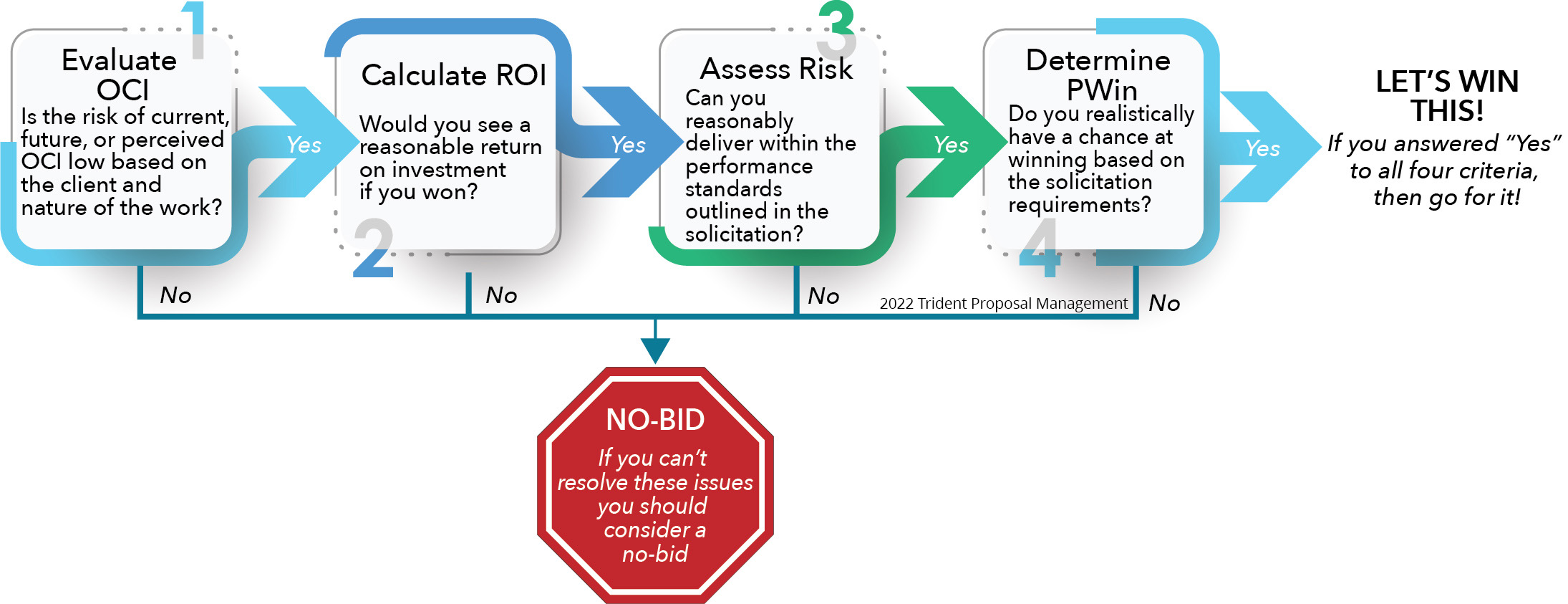4 Ways to Tell a Bid isn't for You
Nov 02, 2022
'To Bid or Not to Bid, that is the question …’ while this ode is a slight variation from William Shakespeare, it forms the foundation for the question you should be asking yourself before you bid on a solicitation. Taking the approach of “submit and see what sticks” doesn’t fare well for your proposal team.
Stop for a moment and ask yourself - how many times have you seen an otherwise competent proposal team underwater on a proposal because they bit off more than they could chew? If your proposal and business development teams are in-lock step from the beginning, making a bid decision should be easy.
Making a good bid-decision is an integral part of a good capture plan and overall successful growth for an organization, regardless of size. If an organization is unable to make bid-decisions efficiently, they will end up wasting thousands of dollars in B&P funds pursuing efforts they are unable to win.
This blog will focus on four evaluation factors that can help you determine whether you should pursue a bid, or invest your resources elsewhere. The below infographic can help you walk through a self-assessment to help with the bid / no bid decision. It’s important to know that a negative response to any question could provide rationale on its own to reach a no-bid decision; answering “yes” to all elements suggests you should proceed with a bid effort. In simpler terms, there is no automatic “yes” but there are automatic “nos”.

For this blog post, we are going to focus on Four Ways to Tell a Bid Isn’t For You:
- Organizational Conflict of Interest (OCI) or a Future OCI: An OCI is defined as
- When a person or organization is unable (or potentially unable) to render impartial support or services to the Government
- The person's objectivity in performing the contract work is or might be otherwise impaired,
- A person has an unfair competitive advantage
An OCI can easily be an award disqualifier. Offerors should take proactive and systematic steps to recognize, avoid, neutralize, and mitigate OCIs or potential OCIs. Many times, you will see this reflected in OCI Plans that are required by the Government for submission.
As a part of the proposal process, offerors should thoroughly analyze actual, potential, or apparent OCIs with every proposal. Take a step back and consider how a present contract might cause OCI concerns in future contracts, or whether a current bid will impact future contracts in your pipeline. By the way, this level due diligence should extend to your teammates as well.
- Reasonable Return on Investment: Time is money, right? A proposal can be an expensive undertaking for an organization, whether it is a large or small business. This bill can grow exponentially based upon whether there are multiple extensions, if outside consultants have been brought in to support the effort, and potential protests (by you or someone else). If there isn’t a feasible way to deliver the products or services (or even submit the proposal), without a significant investment that may or may not be recouped, then it is probably time to revisit the bid decision.
- Risk of Unsuccessful Performance / Unsustainable Requirements: Sometimes proposals and subsequent efforts can be large undertakings, based upon the scope, the complexity, or the size of the effort. Every organization has core capabilities. If the project or requirements are out of scope with your typical portfolio or capabilities, it increases your risk of unsuccessful performance, and therefore should be reevaluated from a bid / no-bid perspective. If an organization attempts to breakout of their core capabilities – specifically with no organized road map or capture plan – executing the effort can be an uphill battle. No organization wants to receive negative feedback. If the project or requirements are unsustainable or not aligned with your long-term business development goals, then that is another red flag for a bid / no-bid decision. If a contract has a minimum contracting threshold, without the risk of being off-ramped, that is another red flag. A key marker in your assessment here is having the right team.
The winning team is ultimately responsible for the success of the effort. Therefore, it is incredibly important to have the team solidified as early as possible in order to capitalize on strengths, mitigate any weaknesses, and solidify a solution. There needs to be a pre-determined timeline or milestones along the capture route for establishing a . It is best to have the team identified and locked in within 30-days of the RFP being released, or at the very latest when the RFP is released. If you are unable to identify your team by the time the RFP drops, it may be time to no-bid. Determining whether your organization can fulfill 60 to 75% of the requirement without support is a valuable marker when making the bid decision. As a general rule, if your organization is not teamed up by the time the RFP is released, then you are officially behind and should re-evaluate whether pursuing the bid still makes sense. - A Low Probability to Win ( The most important question you need to ask yourself is – is there a chance at winning? PWin is one of the concepts that helps us evaluate how well prepared we are for submitting a winning proposal. Assessing the PWin helps the capture team drive pre-proposal activities. If you’re engaged in a capture task that does not materially improve at least one component of PWin, then you’re wasting your time. Unfortunately, PWin is inherently subjective. PWin should be used to frame discussions about the actions being taken to improve the chances of winning. It is ultimately used to determine, 1) competitiveness and 2) actions needed to improve the chances of winning, such as team composition. The actions of the capture team impact and inform the PWin calculation. In our second blog we dig deep into the PWin and have a helpful self-assessment checklist that walks you through determining your PWin score. Included in this assessment is ensuring you have the right team composition. If capture is being done correctly, PWin will increase over time. If the PWin is low because the requirements are written for someone else or you are missing key qualifications (e.g., personnel, certifications), then you should consider not bidding.
Evaluating your proposals against the four criteria above can help you decide early on as to whether you should bid on the next proposal. It can feel hard to make the decision to say “no” but taking the time to evaluate your chances of winning will save you, and your team, a lot in the long run. Remember, sometimes the best bid is ‘no bid’.
Check out part 2 where we walk you through evaluating your PWin and make an informed bid decision



